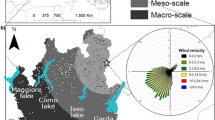Abstract
In the Maujahn peat bog the Slavic period is recorded with a high-resolution pollen diagram in 150 cm of the peat profile. In the upper part of the pollen diagram the time resolution is 3.2 years in the middle and lower part 5.2 years. The Slavic period can be divided into four stages according to different kind of land use and intensity of human influence. The main crop was Secale; less important was the cultivation of Triticum, Panicum, Hordeum, Avena and Pisum. The Slavic period lasted from about a.d. 800–1200. The pollen diagram also displays a final part of the Migration period.



Similar content being viewed by others
References
Averdieck F-R (1974) Zur Vegetations-, Siedlungs- und Seengeschichte. In: Hinz H, Nellisson HE, Helmuth H, Prange W, Averdieck F-R (1974) Bosau. Untersuchung einer Siedlungskammer in Ostholstein 1. Offa-Bücher 31:150–169
Averdieck F-R (1978) Palynologischer Beitrag zur Entwicklungsgeschichte des Großen Plöner Sees und der Vegetation seiner Umgebung. Archiv Hydrobiol 83:1–46
Behre K-E (1981) The interpretation of anthropogenic indicators in pollen diagrams. Pollen Spores 23:225–245
Behre K-E (1992) The history of rye cultivation in Europe. Veget Hist Archaeobot 1:141–156
Beug H-J (2004) Leitfaden der Pollenbestimmung für Mitteleuropa und angrenzende Gebiete. Friedrich Pfeil, München
Christiansen J (2008) Vegetationsgeschichtliche Untersuchungen in der westlichen Prignitz, dem östlichen Hannoverschen Wendland und der nördlichen Altmark. http://webdoc.sub.gwdg.de/diss/2008/christiansen/
Jahns S (2007) Palynological investigation into the Late Pleistocene and Holocene of vegetation and settlement at the Löddigsee, Mecklenburg, Germany. Veget Hist Archaeobot 16:157–169
Jeschke L, Lange E (1987) Zur Landschafts- und Vegetationsgeschichte im Gebiet der Sternberger Seen im Nordwesten der DDR. Flora 179:317–334
Kirleis W (2002) Vegetationsgeschichtliche und archäobotanische Untersuchungen zur Landwirtschaft und Umwelt im Bereich der prähistorischen Siedlungen bei Rullstorf, Ldkr. Lüneburg. Probleme der Küstenforschung im südlichen Nordseegebiet 28:65–132
Lange E (1971) Botanische Beiträge zur mitteleuropäischen Siedlungsgeschichte. Schriften zur Ur- und Frühgeschichte 27. Akademie-Verlag, Berlin
Lange E (1976) Zur Entwicklung der natürlichen und anthropogenen Vegetation in frühgeschichtlicher Zeit. Feddes Repert 87:5–30
Lange E (1980) Ergebnisse pollenanalytischer Untersuchungen zu den Ausgrabungen in Waltersdorf und Berlin-Marzahn. Z Archäol 14:243–248
Lesemann B (1969) Pollenanalytische Untersuchungen zur Vegetationsgeschichte des Hannoverschen Wendlandes. Flora Abt B 158:480–519
Nüsse H-J (2008) Untersuchungen zur Besiedlung des Hannoverschen Wendlands von der jüngeren vorrömischen Eisen- bis zur Völkerwanderungszeit. Neue Ausgrabungen und Forschungen in Niedersachsen 26:9–386
Reimer PJ, Baillie MGL, Bard E, Bayliss A, Beck JW, Bertrand C, Blackwell PG, Buck CE, Burr G, Cutler KB, Damon PE, Edwards RL, Fairbanks RG, Friedrich M, Guilderson TP, Hughen KA, Kromer B, McCormac FG, Manning S, Bronk Ramsey C, Reimer RW, Remmele S, Southon JR, Stuiver M, Talamo S, Taylor FW, van der Plicht J, Weyhenmeyer CE (2004) Intcal04 terrestrial radiocarbon age calibration, 0–26 cal kyr BP. Radiocarbon 46:1,029–1,058
Saile T (2007) Slawen in Niedersachsen. Zur westlichen Peripherie der slawischen Ökumene vom 6. bis 12. Jahrhundert. Göttinger Schriften zur Vor- und Frühgeschichte 30, Wachholtz, Neumünster
Stika H-P, Jahns S (in press) Pflanzliche Großreste und Pollen aus den Slawensiedlungen an der unteren Mittelelbe. Frühmittelalterliche Archäologie zwischen Ostsee und Mittelmeer
Wachter B (1998) Die slawisch-deutsche Burg auf dem Weinberg in Hitzacker/Elbe. Göttinger Schriften zur Vor- und Frühgeschichte 25, Wachholtz, Neumünster
Wiethold J (1998) Studien zur jüngeren postglazialen Vegetations- und Siedlungsgeschichte im östlichen Schleswig-Holstein. Universitätsforschungen zur prähistorischen Archäologie 45, Habelt, Bonn
Willroth K-H (1999) Nordostniedersachsen bis zum frühen Mittelalter. Offa 56:81–91
Acknowledgments
This contribution is dedicated to the late Dr. Brunhilt Lesemann who was the first to study the Holocene vegetation history of the Hanover Wendland for her doctoral thesis at the University of Göttingen. Thanks are due to K.-H. Willroth, Göttingen, for the section ‘Archaeological setting’ and to J. Christiansen, Göttingen, for his help in the field and for producing the figures. Thanks are also due to P.M. Grootes, Leibniz Laboratory, University of Kiel, for providing the radiocarbon data and also to the Landkreis Lüchow-Dannenberg for the permission to work in the protected area of the Maujahn peat bog.
Author information
Authors and Affiliations
Corresponding author
Additional information
Communicated by F. Bittmann.
Appendix
Appendix
As a result of the palynological work, a total of 146 different pollen and spore types have been identified. Many of them, especially those which appear in small numbers, are not included in the pollen diagram. They are listed below.
Tree and shrub pollen types
Juglans, Vitis, Ilex, Aesculus, Juniperus, Myrica, Rhamnus type, Viburnum opulus, Taxus and Cornus sanguinea.
NAP pollen and spore types
Oenanthe fistulosa, Pimpinella saxifraga, Hydrocotyle, Conium type, Gypsophila, Minuartia type, Cerastium type, Silene type, Dianthus, Melandrium, Vicia type, Lotus, Trifolium repens, T. pratense, T. p.p., Lathyrus type, Caltha, Thalictrum, Sanguisorba minor, Solanum dulcamara, Lysimachia vulgaris type, Ballota type, Lamium album, Lythrum, Erodium, Hypericum perforatum type, Centaurea scabiosa type, Cirsium type, Eurumex type, Rumex aquaticus type, Polygonum bistorta type, Valeriana dioica, Viola odorata type, Mercurialis perennis, Gentiana pneumonanthe type, Campanula, cf. Chrysosplenium, Thesium, Knautia, Succia, Scabiosa columbaria type, Parnassia, Liliaceae, Symphytum, Drosera rotundifolia, Alisma type, Utricularia, Myriophyllum spicatum, Potamogeton natans type, Menyanthes, Athyrium, Dryopteris filix mas, Thelypteris palustris, Ophioglossum, Botrychium, Polypodium, Lycopodium clavatum type, Lycopodium annotinum type and Lycopodiella inundata.
Rights and permissions
About this article
Cite this article
Beug, HJ. Vegetation changes during the Slavic period, shown by a high resolution pollen diagram from the Maujahn peat bog near Dannenberg, Hanover Wendland, Germany. Veget Hist Archaeobot 20, 199–206 (2011). https://doi.org/10.1007/s00334-011-0284-4
Received:
Accepted:
Published:
Issue Date:
DOI: https://doi.org/10.1007/s00334-011-0284-4




